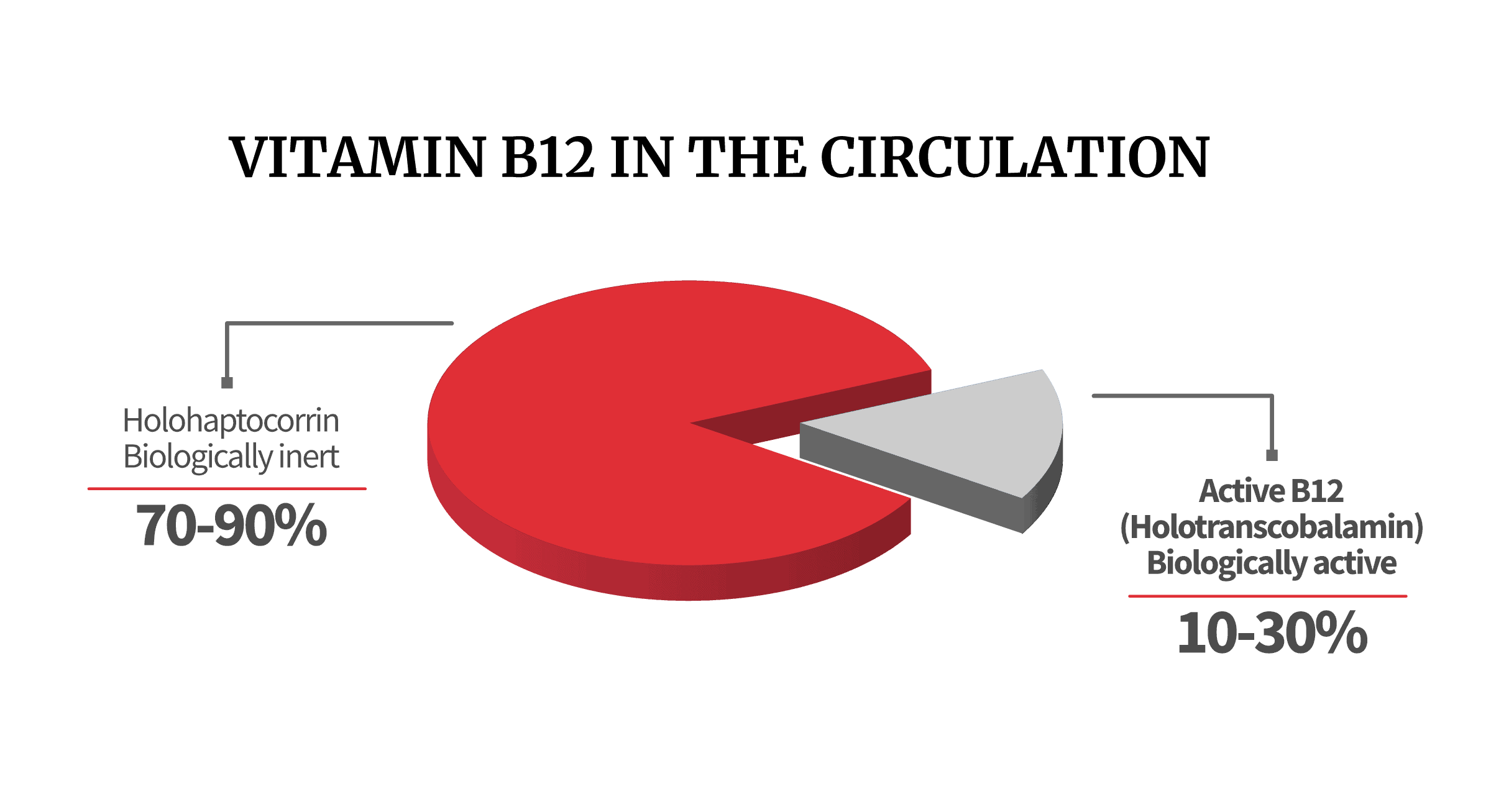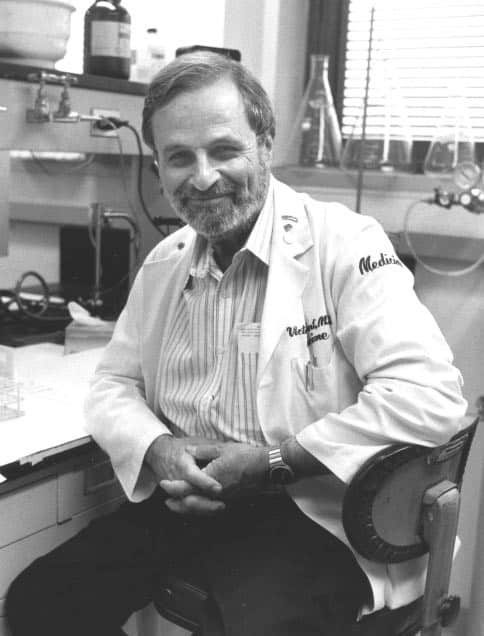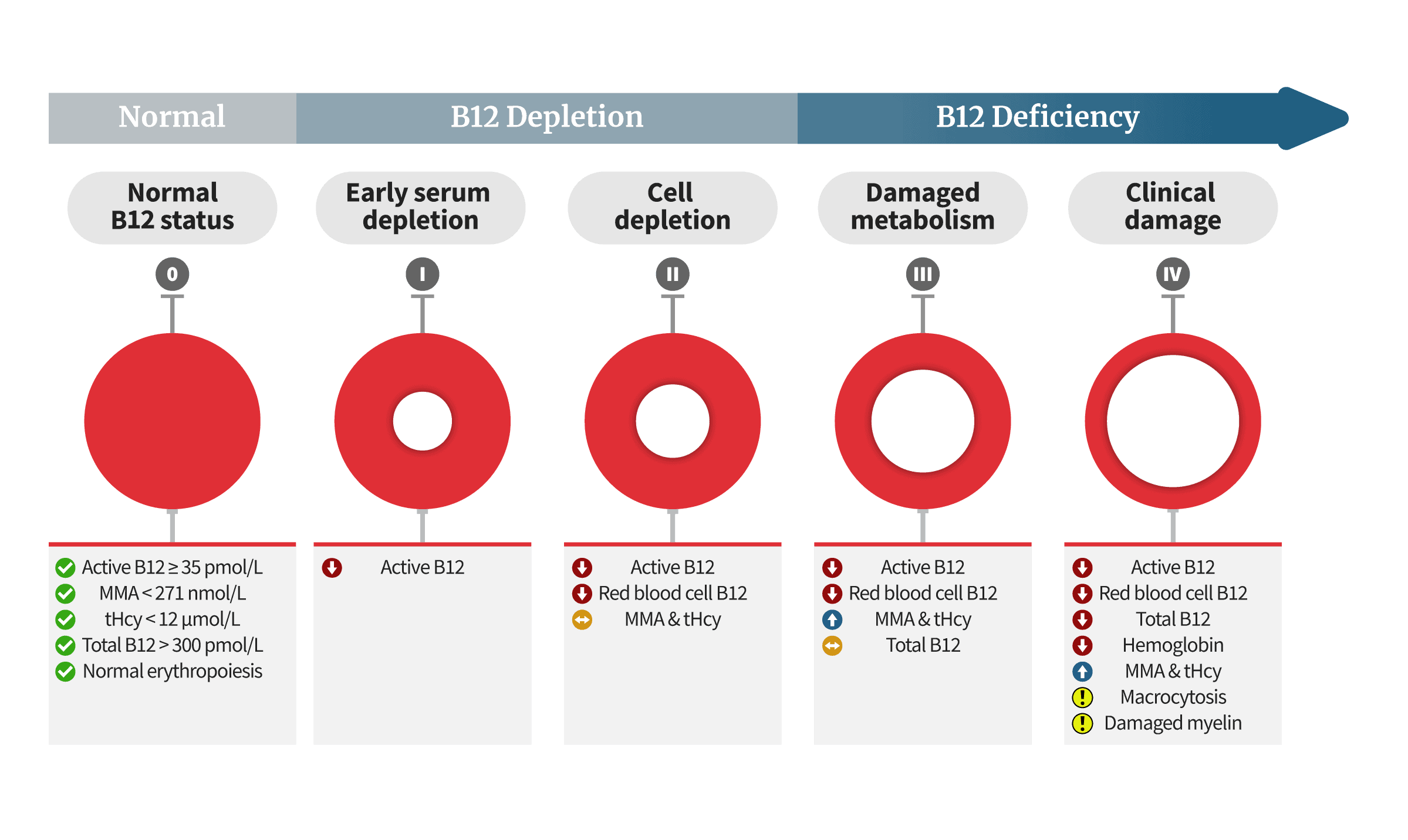Holotranscobalamin represents only 10-30% of the B12 circulating in the blood but is the only form of B12 that is taken up and used by cells of the body, hence it’s other name – active B12.
Active-B12, the next level of B12 testing; Axis-Shield
The active-B12 test (or holotranscobalamin test) from Axis-Shield is a novel and highly reliable method for assessing vitamin B12 status. The test offers improved accuracy, sensitivity, and specificity compared to current, outdated front-line blood tests.
But first, what does active B12 even mean?
What Is Active B12 (HoloTC)?
Approximately one-quarter of circulating vitamin B-12 binds to transcobalamin and is thereby available for the cells of the body. For this reason, holoTC is also referred to as active vitamin B-12. To date, holoTC has not been used for population-based assessments of vitamin B-12 status, but we suggest that holoTC is a better marker than total vitamin B-12 for such studies.
Holotranscobalamin, a marker of vitamin B-12 status
Within our body, three carrier proteins are involved in the transport of B12. One of them is intrinsic factor, against which the body creates antibodies in cases of pernicious anemia, while the other two are transcobalamin (TC) and haptocorrin (HC).
When transcobalamin and haptocorrin bind to the B12, the resulting complexes are known as holotranscobalamin (holoTC) and holohaptocorrin (holoHC).
Of these proteins, only transcobalamin can carry the B12 that was absorbed into the ileum, and move it further down to the tissues. Once there, the holoTC complex (the active-B12) is integrated through a specific receptor-mediated uptake, delivering B12 into the cells, where it acts as a co-enzyme for vital cellular functions.
What happens to the remaining B12 circulating in the blood? It is bound to haptocorrin, creating the biologically-inert complex holoHC. We’re not fans of the regular B12 blood test, because it fails to distinguish between active B12 and inactive holoHC. This is a serious issue, because active B12 can make up as little as 10% of your total B12:

As a result, an active-B12 deficiency can easily exist within what looks like a normal total-B12 status, and many genuine B12 deficiency cases end up undiagnosed.
From these results it can be concluded that serum concentration of holoTC is a much better predictor of B12 status than total B12.
The usefulness of holotranscobalamin in predicting vitamin B12 status in different clinical settings
Why We Prefer The Active-B12 Test
HoloTC has a better diagnostic accuracy than vitamin B(12) and can replace the existing vitamin B(12) assay as a primary screening test in patients suspected of vitamin B(12) deficiency.
Screening for metabolic vitamin B12 deficiency by holotranscobalamin in patients suspected of vitamin B12 deficiency: a multicentre study
Active B12 is the only B12 complex that the body can effectively utilize, unlike the inactive haptocorrin-bound analogues. That’s why we recommend the active-B12 test. Your total-B12 levels are largely irrelevant, because only the transcobalamin-bound B12 can penetrate the cells and tissue. And since it can be as low as 10% of your total-B12 levels, the traditional B12 blood test can easily give a misleading picture.
Here’s how important active B12 is:
There’s a genetic condition in which the body has an absence of haptocorrin. However, it’s not life-threatening, and doctors often discover it accidentally. In contrast, the absence of transcobalamin is very serious, and it manifests as the typical symptoms of deficiency in B12. Doctors often diagnose it shortly after birth due to failure to thrive, and it requires immediate B12 therapy, otherwise irreversible neurological damage takes place.
In such cases, and in other situations where transcobalamin is compromised, you may be fooled by the healthy B12 levels that show up in the normal blood test, while an active-B12 test would have discovered the B12 deficiency. Thus, we predict the active-B12 test will one day replace the normal test as the default diagnostic tool. Hopefully soon:
Compared to total cobalamin, we observed a better performance of holoTC assay in detecting elevated concentrations of MMA in subjects with normal renal function. The majority of subjects with combined low holoTC and elevated MMA had normal concentrations of total cobalamin. HoloTC can be used as a first line parameter in detecting cobalamin deficiency.
Holotranscobalamin in laboratory diagnosis of cobalamin deficiency compared to total cobalamin and methylmalonic acid
This case study demonstrated that 5 different Total-B12 assays from 4 manufacturers all gave falsely elevated results in a patient with confirmed pernicious anaemia. The same failing described by Carmel, Agrawal, Yang and Cook is again apparent in this case study and demonstrates why Total-B12 results can be unreliable.
FALSELY ELEVATED COBALAMIN CONCENTRATION IN MULTIPLE ASSAYS IN A PATIENT WITH PERNICIOUS ANAEMIA: A CASE STUDY
After excluding 20 cases of incident dementia, increased tHcy remained associated with poorer performance in episodic memory, execution functions and verbal expression. Higher holoTC levels tended to be related to better performance in executive functions and psychomotor speed, while elevated serum folate concentrations were significantly related to higher scores in global cognition and verbal expression tests.
Serum homocysteine, holotranscobalamin, folate and cognition in the elderly
We confirm a decrease in cobalamins during pregnancy, and report that the active part of cobalamins (holotranscobalamin, holoTC) remains unchanged. The decrease in cobalamins is explained by a decreased holohaptocorrin (holoHC), suggesting that holoTC rather than cobalamins should be used as a marker of vitamin B12 deficiency during pregnancy.
Holotranscobalamin remains unchanged during pregnancy
No association between serum vitamin B₁₂ concentrations and cognitive decline or dementia was found. However, four studies that used newer biomarkers of vitamin B₁₂ status (methylmalonic acid and holotranscobalamin (holoTC)) showed associations between poor vitamin B₁₂ status and the increased risk of cognitive decline or dementia diagnosis.
Vitamin B12 status, cognitive decline and dementia
Another advantage of the active-B12 test is its novel monoclonal antibody, which is incredibly accurate at detecting holoTC (active B12). This allows for a simpler and more direct way to measure active B12 levels. It cuts out the need for the complex preliminary steps required by most B12 tests, eliminating a potential source of inconsistency.
Another benefit is that compared to holohaptocorrin (inactive B12), holotranscobalamin has a shorter circulating half-life. This means that when you’re approaching a negative B12 balance and entering the low range of B12 levels, the earliest change that actually occurs is very likely to be a decrease in the levels of active B12 specifically.
Expert Consensus
More than a decade ago, a panel of experts produced a consensus statement on the improved utility of the active-B12 assay over total B12. Like the collective opinion of these experts, and for the above reasons, we highly recommend the holotranscobalamin test as the optimal marker for true B12-status. Other professionals agree:
Active-B12 has fulfilled our expectations in being a robust assay that improves the assessment of vitamin B12 status. It provides reassurance to us that we have contributed to improved patient care. The routine availability of this assay differentiates our laboratory as a progressive provider of quality pathology.
Dr .Ken Sikaris, Melbourne Pathology, Australia
Serum holoTC was the best predictor, with area under the ROC curve (95% CI) 0.90 (0.86-0.93), and this was significantly better than the next best predictors; serum cobalamin, 0.80 (0.75-0.85), and MMA, 0.78 (0.72-0.83). This study supports the use of holoTC as the first-line diagnostic procedure for vitamin B₁₂ status.
Diagnostic Accuracy of Holotranscobalamin, Methylmalonic Acid, Serum Cobalamin, and Other Indicators of Tissue Vitamin B12 Status in the Elderly
HoloTC levels were more sensitive than the serum vitamin B12 levels for indicating vitamin B12 status. If the serum vitamin B12 level is 151-300 pmol/L, the levels of holoTC alone or in combination with serum vitamin B12 levels are likely to be more useful markers than serum vitamin B12 levels alone.
Relationship between the Levels of Holotranscobalamin and Vitamin B12
Testing for vitamin B12 deficiency should start with holotranscobalamin measurement. Holotranscobalamin between 23 and 75 pM should be followed by MMA testing that can filter substantial number of deficient cases in the grey range in individuals with normal renal function. This diagnostic strategy may significantly improve assessing vitamin B12 deficiency.
UTILITY AND LIMITATIONS OF BIOCHEMICAL MARKERS OF VITAMIN B12 DEFICIENCY
Total serum cobalamin is neither sensitive nor it is specific for cobalamin deficiency. This might explain why many deficient subjects would be overlooked by utilizing total cobalamin as status marker. Concentration of holoTC in serum is an earlier marker that becomes decreased before total serum cobalamin.
Cobalamin deficiency
Victor Herbert & Holotranscobalamin
We can’t discuss active B12 without paying homage to Dr. Victor Herbert, a legendary physician and hematologist who was the prime proponent for testing for holoTC, or active-B12 levels.
Dr. Herbert was also a prolific expert on the metabolism of B12 and folate, on which he had authored several scientific papers, some of which are considered ground-breaking, landmark classics.
During his career, he was Professor of Medicine at the Mount Sinai School of Medicine in New York and Chief of Mount Sinai’s Hematology and Nutrition Research Laboratory in the Bronx Veterans Affairs Medical Center.

Dr. Herbert was perhaps most famous for his self-experiment, where he induced folate deficiency in himself by eating a diet of boiled vegetables. He almost killed himself in the process, waking up unable to walk. He did all that, in order to document the stages and progress of folate deficiency up until its end point of megaloblastic anaemia.
About forty years later, on November 19, 2002, Dr. Herbert died at his home in NY. At a forum held in Philadelphia less than a month later, Dr. Ralph Green read a tribute:
On Christmas Day 1961, he reached the end of one such study. Unable to move from severe weakness in both lower limbs induced by potassium deficiency caused by ingestion of an experimental diet, and having lost 26 pounds, Dr. Herbert terminated what came to be regarded as a classic self experiment. He had induced in himself nutritional folate deficiency by eating a diet of foods re-cooked to destroy all traces of folic acid. He had, as a consequence, developed megaloblastic anemia. Through this experiment, Dr. Herbert conclusively proved the tie between folate deficiency and megaloblastic anemia. He was also able to carefully document the sequence of changes in the development of folate deficiency. It was this spirit of scientific curiosity and indomitable grit and determination that characterized Victor Herbert’s life and career.
Obituary, Victor Herbert, M.D., J.D.
If you’re interested, here’s another article in memory of Victor Herbert, written by Dr. Charles Halstedand, and published in the American Journal of Clinical Nutrition.
An adaptation of Dr. Herbert’s proposed model is shown in the diagram below, describing the biochemical, metabolic, and clinical changes that take place as vitamin B12 repletion progresses to depletion, and finally to clinical B12 deficiency:

For his groundbreaking contribution to the field of vitamin B12 and to our understanding of its metabolism, we would like to thank Dr. Herbert from the bottom of our heart. As you can see from his model, the very first step of B12 deficiency is decreased active-B12 levels. This is exactly why the active-B12 blood test should be the first line of defense in diagnosing B12 deficiency cases, while they’re still recoverable and easy to treat.
In Conclusion
An international expert group of key opinion leaders met in March 2012 to review the current practices of testing for vitamin B12 deficiency. The experts agreed that active-B12 offers a more reliable assessment of vitamin B12 status and as an output from the discussion a consensus statement was produced:
Active-B12, the next level of B12 testing; Axis-Shield
“Emerging evidence indicates that active-B12 is a more reliable marker of B12 status than serum vitamin B12”.
To sum up, the active-B12 blood test represents a major step-up over the current test, because it gives us a much more accurate picture of the levels of bio-available B12. We hope the test will become widely available in routine laboratory settings and in research. It will improve the lives of millions, and it will make the task of vitamin B12 deficiency diagnosis easier for the laboratorian, the doctor, and the patient.
Thanks for reading.


